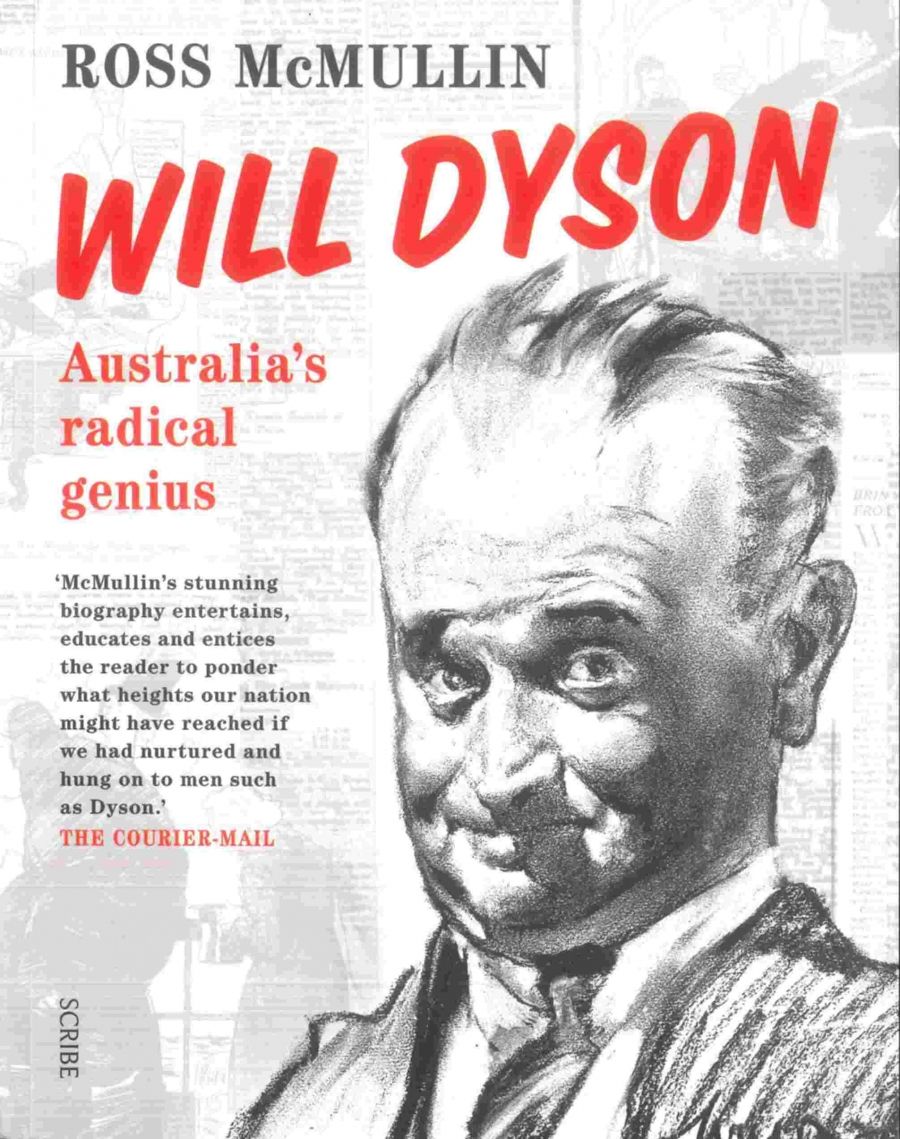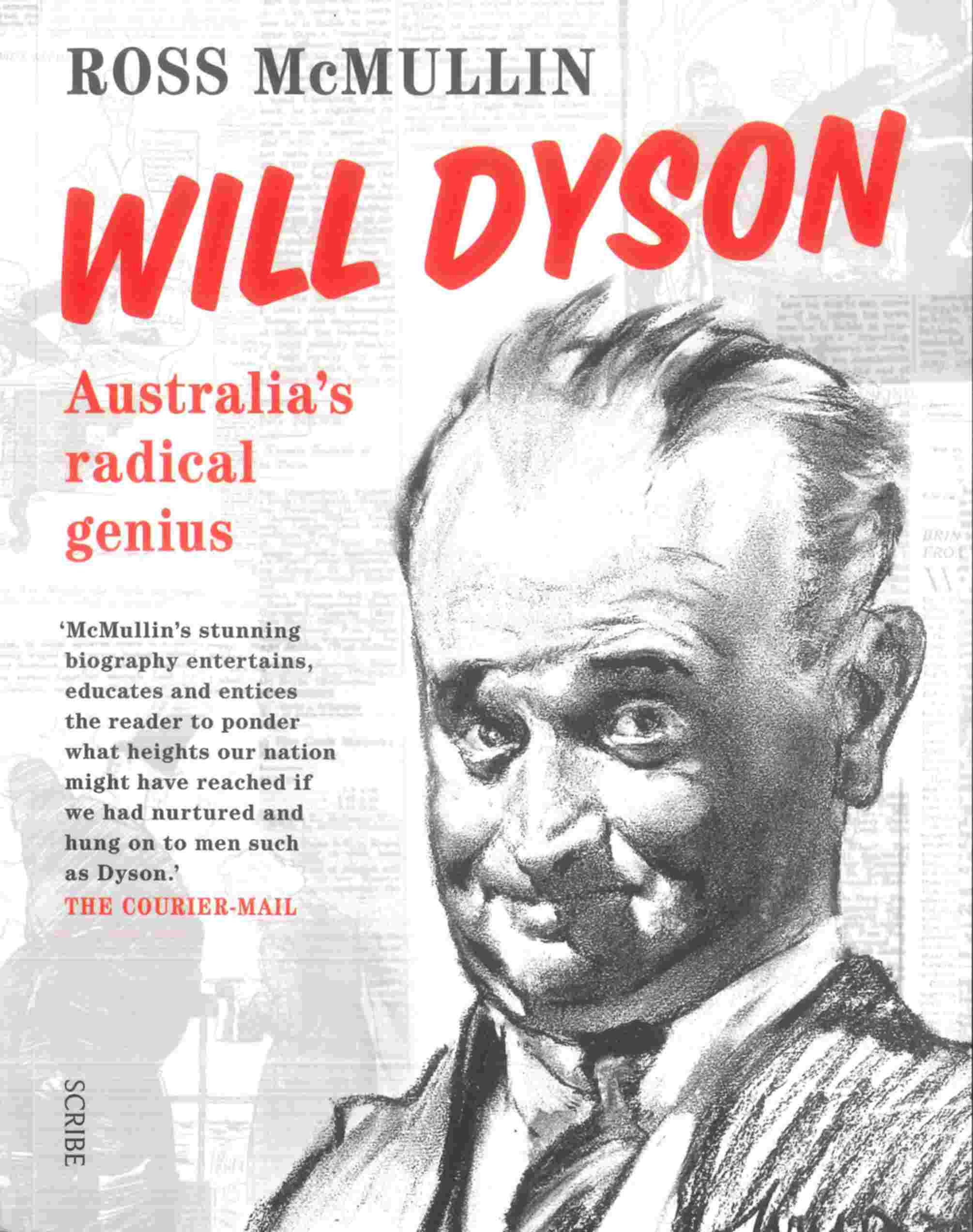
- Free Article: No
- Contents Category: Cartoons
- Review Article: Yes
- Article Title: Similar Will
- Online Only: No
- Custom Highlight Text:
Ross McMullin’s Will Dyson is a new edition of a book that first appeared twenty years ago. Over that time, the author has promoted his subject, according to the book’s subtitle, from ‘Cartoonist, Etcher and Australia’s Finest War Artist’ to ‘Australia’s Radical Genius’. ‘Genius’ is a strong word, and the new edition does not make a case for its use any more than the old one did. But Dyson is certainly an important, often unregarded, figure in the history of political cartooning. The story of this talented, likeable, thoroughly political man is well worth knowing on many fronts: as a saga of early Melbourne working-class bohemian culture, as an example of the invigorating effect on English political cartooning by antipodean artists in the early part of the twentieth century (the career of David Low shadows that of Dyson), and as an account of the way that World War I registered on a sensitive, and responsible, Australian imagination.
- Book 1 Title: Will Dyson
- Book 1 Subtitle: Australia’s radical genius
- Book 1 Biblio: Scribe, $59.95 hb, 448 pp
- Book 1 Cover Small (400 x 600):

- Book 1 Cover (800 x 1200):

Will Dyson was born near Ballarat in 1880, and grew up in Melbourne in a family that included, among its ten surviving children, several with journalistic or literary ambitions. A reader, conversationalist and speechmaker as much as an artist, even something of a poet, Dyson instantly fell in with Norman Lindsay, joining Lindsay’s prehistoric clubs, acting in his neo-pagan pageants and tableaux, and eventually marrying his gifted sister, Ruby. (The couple later quarrelled with Lindsay.) Dyson published widely in Australia, notably in The Bulletin and The Lone Hand, before leaving for England in 1909.
Settled in London, Dyson joined The Daily Herald, a worker’s newspaper forged in the fire of the London printers’ strike of 1911, quickly making a name for himself as a left-wing cartoonist. G.K. Chesterton, in praise repeated in different terms by many others, called him the ‘most original and penetrating English artist of our time’, not knowing, not remembering, or not caring if he did know, that Dyson was Australian. World War I was undoubtedly the most important event of his life. In 1916, aged thirty-six, Dyson was accepted as an accredited war artist. He spent two gruelling years in France, producing important work –– not cartoons, but a wide variety of drawings, lithographs, and paintings of life on the battlefield, in the trenches, and in the ruined towns and countryside of northern France. Afterwards, he returned to The Daily Herald, publishing in 1919 his most famous, striking and grimly prophetic cartoon, ‘Peace and Future Cannon Fodder’.
That same year Ruby died, a victim of the Spanish Influenza epidemic. A fractured Dyson eventually returned to Australia in the company of his precocious daughter, Betty. Her life, like her mother’s, would repay further attention: beautiful, gifted (she designed all 4000 costumes for the Pageant of Parliament in 1934), snobbish, worldly, Betty married a Breton baron, was suspected of being a collaborationist in wartime France, divorced her husband, made an abusive second marriage, and died a recluse in Jamaica in 1956. This new edition prints an extraordinary photograph of her, proud and gorgeous, hands on hips, pressing her shoe firmly into the ear of her prostrate father’s adoring, ground-scraping head. She wears an indescribable ex-pression of pleasure and self-satisfaction: The New Woman/Gynocracy Triumphant.
As to her father, unhappy at Keith Murdoch’s Melbourne Punch, and later The Herald, he soon discovered that Australia was ‘a backwater, a paradise for dull boring mediocrities, a place where the artist or the man with ideas could live only on sufferance’. He retreated to England, but it was too late. Despite some success in America, the times had overtaken him, and Dyson never caught up. His work’s abrasive surface was smoothed over, and he missed by a mile the economy of style that the age demanded of its comic art: ‘he has lost something of his old admirable ferocity’ was the verdict of The New Statesman. He died in January 1938, less than two years shy of seeing the prophecy of ‘Peace and Future Cannon Fodder’ realised.
It is good to have this absorbing book, from which all the details above derive, back in print. McMullin is especially rewarding to read on the social and wartime background to Dyson’s life. But whether the new edition lives up to the claims of the author’s introduction –– ‘updated and comprehensively rewritten … the writing, the illustrations, the design, the cover, and the publisher are all different … [h]ardly a paragraph remains unaltered’ – is debatable. True, cover and publisher are different. The newness of the illustrations means, however, not a different, or even expanded, selection – there are ten new images out of 131, but ten of the original ones have been dropped, including a couple with an anti-Semitic slant – but, presumably, that the images have been rescanned and Photoshop-enhanced, certainly to advantage. Nothing by Ruby or Betty has been included, a missed opportunity, and it would also have been good to have a few by Dyson’s contemporaries and avatars – Phil May, Lindsay or Low, among others – for purposes of comparison. An embarrassing oversight is the new reproduction of Dyson’s Daily Herald poster. In the old edition, it was outlined onto a black background. It now shows the hands, knee and foot of whoever was holding up the poster for the photographer.
The design is also better, but has not improved the relation between text and illustration. Ideally in such a book, illustrations should either appear on the page on which they are discussed, or there should be a clear numbering system to enable the reader to move between text and image. Neither principle has been adopted in Will Dyson. Images generally precede or follow their discussion in the text by a page or two, in haphazard fashion. When an image does appear on the page where it is discussed (as it does, unusually, with ‘Dead Beat’), this emphasises the lack of correspondence elsewhere. In an extreme case, as with ‘The Mate’, the discussion is separated by more than 100 pages from the illustration, tucked away in the colour section with no plate number to help, and no indication in the text that the image will be reproduced later. Additionally, the captions that accompany the images are inadequate: there is no consistent citation of dates, no indication of size or medium, no authorial legend (except for photographs), and the caption text is set in bold and plain capitals, an outdated look.
The book has been re-edited into prose that is generally crisper, leaner and more direct. The previous edition’s long, dangling sentences are largely gone. In this sense, it is true that few paragraphs remain exactly the same. A small amount of text has been modified or dropped and there is some new material, such as the additional thousand or so words at the end.
A ‘comprehensive rewriting’ this is not. The phrase implies a major rethinking of the enterprise from the ground up. Such a revision could go in one of several ways. It might tackle the issue of ‘genius’ raised in the new subtitle; the question of how good a cartoonist Dyson really was. In truth, a lot of his work is laboured, often lacking the inspiration that instantaneously flashes penetrating political in-sight into irrefutable pictorial allegory, the mark of the great cartoonist. Occasionally – ‘A Voice from Anzac’ or ‘Xmas Memories’ – he collapses into pure sentimentality. Or the new edition might aim for a more reflective and imaginatively inward, and hence biographical, account of Dyson’s life and times. This is not attempted. As it stands, Will Dyson (2006) is essentially the same book as Will Dyson (1984).


Comments powered by CComment